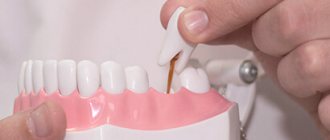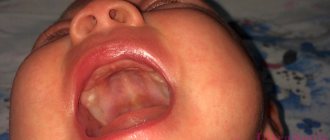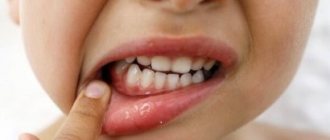Features of the oral cavity
The mucous membrane of a healthy child's mouth is bright pink due to the large number of blood vessels. As she grows older, her shade fades.
The epithelial layer is distinguished by tenderness and vulnerability, as well as some dryness due to the not very active work of the salivary glands (up to 3-4 months).
The baby's mouth is ideally suited for sucking. A wide tongue, a fold on the gums formed by the mucous membrane, pads on the inside of the lips, a “suction cup” on the upper lip - all this provides a tight grip on the bottle or nipple and facilitates the process of obtaining food.
What features or problems can be detected by looking into a baby’s mouth? Main options:
- white bumps on the palate;
- abnormal appearance or position of the tongue;
- white plaque on the inside of the mouth.
"Epstein's Pearls"
In 65-85% of babies after birth, several yellow-white tubercles with a diameter of 1-3 mm are found along the palatine suture. They are called palatal cysts or “Epstein's pearls.”
They are formed from residual fragments of the epithelial lining, which is destroyed under the influence of enzymes during fetal development. Epstein Pearls are filled with keratin.
Palatal cysts do not require treatment and do not cause discomfort to the child. They atrophy on their own in the first months of life.
Treatment of ENT diseases in infants
The most important task in the treatment of otolaryngological diseases is to prevent the disease from becoming chronic. Therapeutic (drug, physiotherapeutic) methods are used in the treatment of ENT pathology. In recent years, minimally invasive laser and endoscopic methods have been actively used to treat otolaryngological pathologies.
Prevention of diseases of the nasopharynx, larynx and hearing organs in children must be applied from a very early age. A qualified pediatric ENT specialist will help you develop a plan of preventive measures that will help your baby avoid chronic colds and infectious diseases, as well as the risk of various complications.
Remember that, regardless of age and general condition of the body, a child requires constant attention. A pediatric ENT doctor will always help to diagnose the disease in a timely manner, establish its causes, and also prescribe appropriate treatment and prevent possible complications.
Language
Normally, the tongue is located along the midline of the jaw. If there is a constant deviation (recession) to the right or left, parents should show the child to a neurologist. This symptom may indicate damage to the caudal group of nerves of the skull. An additional sign is a drooping soft palate.
Another reason to seek help is that the language is too broad. This symptom is observed with hypothyroidism (decreased functional activity of the thyroid gland) and some genetic syndromes.
The listed phenomena are rare, unlike a short hyoid frenulum. This minimal anomaly in the structure of the maxillofacial apparatus can be determined visually; in addition, when screaming, the tip of the baby’s tongue rises. A short frenulum is not dangerous, but it can make sucking difficult and, in the future, complicate the pronunciation of sounds. In infancy, it is easily cut with a scalpel in an outpatient setting without suturing and virtually no blood.
White plaque
The tongue and palate of an infant may be covered with a thin whitish coating. Main reasons:
- leftover food;
- mouth breathing;
- thrush.
Leftover food
Immediately after feeding, you can see the remains of breast milk or formula on the baby's tongue and palate. After some time, the plaque disappears on its own. Many pediatricians advise removing traces of food from the baby’s mouth, as they serve as a breeding ground for opportunistic microorganisms.
Cleaning methods:
- give the baby 1-2 teaspoons of boiled water immediately after feeding;
- wipe the epithelial membrane 2 times a day with soda solution or water (the procedure is described below).
If the plaque is easily removed or disappears on its own (it is not present before feeding), do not worry. But in cases where white marks on the tongue, palate and inner surface of the cheeks are constantly present, it is necessary to consult a doctor.
Mouth breathing
If a child breathes through his mouth, his mucous membrane dries out and a whitish coating forms on it. In children under one year of age, this phenomenon is most often caused by acute respiratory viral infections and dry air in the room, which leads to the formation of crusts in the nasal passages.
The only way to prevent the formation of white plaque is to restore nasal breathing in the baby. Basic methods:
- when the mucus dries out, instill saline and oil drops into the nose, as well as humidify the air;
- for a runny nose and congestion due to ARVI - similar measures, in addition, the doctor may recommend the use of vasoconstrictor drops (no longer than 5-7 days).
The essence and causes of thrush
Microscopic yeast-like fungi of the genus Candida live on the mucous membranes and skin of every person. They do not cause harm to health, but only if the immune system suppresses their active reproduction. Otherwise, an inflammatory disease called candidiasis occurs. If fungi colonize the oral mucosa, candidal stomatitis, or thrush, is diagnosed.
The disease is detected in 4-5% of infants. Its main reasons:
- low level of immunity, characteristic of all newborns;
- decrease in protective forces as a result of teething, acute respiratory infections, dysbiosis, intestinal infection, and so on;
- non-compliance with hygiene standards - insufficient cleaning of children's dishes, toys, mother's skin (during breastfeeding);
- antibiotic treatment, which disrupts the balance of bacteria on the mucous membranes;
- drinking sweet tea, water, compote or a mixture - leftover sugar in the mouth contributes to the growth of fungi.
In addition, a baby can “get” too many candida when in contact with adults. Most often, infection occurs during childbirth if the mother has genital thrush. Kissing and sharing utensils can also lead to infection if an adult has candidal stomatitis.
White spots or dots on the gums, mouth and tongue of a baby
Young mothers are very worried if they notice that not everything is all right with their child. This is especially true for infants: tiny babies quickly react to various changes, begin to act up and get sick
Important attention should be paid to the baby’s oral cavity at the time of teething. If you notice white spots on your baby's gums, you should not ignore it.
- 1 Read more
- 2 Reasons
- 3 Stomatitis
- 4 Prevention
More details
A white spot, bumps, pearls in the mouth and on the tongue are a significant reason for concern. If your child’s gums are also red and the temperature has risen, it is better to immediately show him to the pediatrician. He will find out the reason and help dispel doubts. What could such phenomena mean?
You don't always need to panic. Even if a child has a white pimple in his mouth, natural causes can sometimes contribute to this. White balls and spots in the mouth may appear before the first teeth. If your baby’s teeth itch at 3-4 months, there’s no need to worry either. Expect your first tooth to appear soon.
Causes
Below are the reasons for this phenomenon.
- Epstein's pearls. They are brushes that are formed from epithelial inclusions. They closely resemble real pearls and cones, hence the name. You cannot touch such formations; they will disappear on their own after a while.
- Bon's knots. They occur not only on the gums in the mouth, but also on the cheeks, sometimes on the tongue. These are tiny brushes made from dental plate. May resemble the shape of the first teeth. However, they will also soon resolve on their own, so there is no reason to worry.
- Sometimes white spots and bumps in the mouth are so-called congenital teeth. In this case, the child must be shown to a doctor, since additional teeth must be removed. It is necessary to urgently contact a pediatrician if hematomas appear on the gums and tongue and begin to bleed. This may indicate the development of oral diseases. If left untreated, this can lead to serious problems in the future that can lead to tooth loss.
Stomatitis
Sometimes pearls, bumps, bumps and spots on the tongue may indicate stomatitis - inflammation of the oral mucosa. Infants are more often susceptible to stomatitis, since their body is not yet able to resist viruses and bacteria. Not all parents know the rules for caring for their child’s oral cavity, so they do not pay due attention to it.
The mucous membrane can be severely damaged if not properly cared for.
Therefore, this must be done very carefully; sharp and hard objects are excluded.
White dots, bumps and spots are a characteristic sign of stomatitis. The quantity, appearance, location will depend on the type of disease:
- viral. Occurs against the background of other diseases and inflammatory processes. For example, if a baby has the flu, bronchitis, or chickenpox, there may be white spots and bumps on the gums, and in large quantities. In this case, the baby is shown to the doctor, since tubercles in the mouth are a dangerous phenomenon;
- allergic. Asthma, allergies, atopic dermatitis are companions of white formations in the mouth. Usually they are only on the tongue;
- bacterial. If your baby catches an infection, he may develop a fever. This will be accompanied by a white coating throughout the mucous membrane and on the tongue, as well as blisters that bleed heavily and even hurt. The condition requires immediate medical intervention.
Young mothers often have a lack of calcium in the body. This also affects the baby’s health: an unhealthy white coating appears in the mouth. Sometimes attentive mothers mistake the remaining milk in the baby’s mouth for plaque. In this case, you need to pay more attention to hygiene.
Symptoms of oral candidiasis
The main sign of thrush in an infant is a permanent white coating, reminiscent of cottage cheese or yogurt, on the tongue, palate, gums, inner surface of the cheeks, and lips. At first it looks like small spots (“plaques”), which gradually grow. If you remove them with a bandage, a bright red inflamed mucous membrane is revealed.
As the disease progresses, the white spots become yellow or grayish. Small bleeding erosions form under them. The child experiences discomfort, therefore behaves restlessly and sleeps poorly. When sucking, the unpleasant sensations intensify, as a result, many infants refuse to eat.
In severe cases, fungal microflora leads to the formation of a dense film on the oral mucosa. Over time, it spreads to the throat, tonsils, esophagus and internal organs. The child may have a fever and a significant deterioration in general condition.
Help for thrush
A pediatrician may suspect thrush based on an examination of the oral cavity. To confirm the diagnosis, it is worth taking a swab from the throat and determining the state of the microflora. If the number of Candida fungi exceeds the norm, the child has candidal stomatitis.
Local treatment
In most cases, local treatment of thrush is carried out in infancy. The safest method is to wipe the oral mucosa with baking soda. Stages:
- Prepare a weak solution of soda - 1 small spoon per 1 glass of boiled warm water.
- Wrap a sterile bandage around your clean index finger.
- Soak the bandage in a soda solution.
- Wipe the baby's mouth. There is no need to try to remove the plaque, just carefully treat it from above.
The procedure should be repeated every 2-3 hours for several days. If the child does not open his mouth, you should press your finger on the chin and hold it.
Another method of treatment is wiping the mouth according to the scheme described above with a solution of honey and warm water (in a ratio of 1:2). Honey has antimicrobial and anti-inflammatory effects. But you should remember that it is a very strong allergen.
If traditional methods do not help get rid of stomatitis, the doctor may prescribe external antifungal agents. Here are some of them:
- acidophilus powder;
- Candide solution;
- nystatin ointment;
- Shostakovsky balm;
- gentian violet solution and so on.
The method of their use is indicated in the instructions. Usually it is necessary to apply an ointment or solution to the mucous membrane several times a day. The duration and dosage are determined by the doctor.
Systemic drugs
In case of advanced candidiasis, systemic antimycotics are prescribed in parallel with local remedies in a dosage that is safe for a small child. The main drugs are Diflucan, Mycomax, Nystatin, Amphotericin B, Ketoconazole. They should be given to the baby for 5-10 days. It is important to follow the treatment period determined by the doctor, even if the symptoms of candidiasis have disappeared.
If your baby suffers from pain, you can give him ibuprofen in an age-appropriate dosage or paracetamol. In addition, it is advisable to use local analgesic gels, which are used during teething.
Along with the destruction of fungal flora, it is important to pay attention to increasing the child’s immunity. According to the doctor's decision, it is worth giving him B vitamins. If dysbiosis is present, it must be treated. It is recommended that a nursing mother undergo antifungal therapy with her baby, even if she has no symptoms.
Diagnosis of ENT diseases in infants
Examination and treatment of children differs markedly from working with adult patients. A young patient cannot always clearly explain what is bothering him; he does not know how to properly dissolve pills or gargle. The ability and skills of a good pediatric ENT doctor to find an approach to a sick child and establish psychological contact with him are no less valuable than the professional skills of an otolaryngologist. The physiological and anatomical characteristics of a small child’s body determine the specificity of treatment procedures, examination of ENT organs, and anesthesia (if necessary).
Modern methods for diagnosing ENT pathology include: clarification of parental complaints, questions of the diagnostic and treatment complex, etc., objective examination, laboratory tests, endoscopic and computer studies of the nose, throat, and ear, ultrasound.
Prevention
The risk of developing candidal stomatitis is especially high in the first 6 months of a baby’s life, since his immune system is just developing. To prevent disease, it is important to follow the following rules:
- rinse your breasts with clean water before feeding;
- offer the baby some water after a meal or burping;
- strictly observe the rules of hygiene for all adults in contact with the child;
- Regularly sterilize bottles and pacifiers.
After an illness, to prevent re-infection, it is worth boiling all toys and children's dishes. If the item cannot be treated with hot water, it is recommended to rinse it with a soda solution.
The main reason for a white palate in a baby is the accumulation of food debris in the mouth after feeding. Traces of formula or milk disappear on their own and are not visible before the next meal. Persistent plaque in most cases is a sign of candidal stomatitis (thrush). This disease is treated with local and/or systemic agents with an antiseptic effect. At the initial stage, thrush is not dangerous, but as it progresses it can lead to the formation of ulcers on the mucous membrane and the spread of infection.
Hearing loss
This is a disease characterized by hearing loss, even complete loss. The pathology occurs among people of different age categories; it can be a congenital or acquired problem. Hearing loss in newborns most often appears as a result of a woman suffering from any infectious or viral diseases during pregnancy.
The problem of hearing impairment in newborns is very relevant from both a social and medical point of view. The thing is that hearing loss in a child leads to deviations in speech development and affects intelligence and personality formation.
Therefore, even before discharge, in many modern maternity hospitals, every baby undergoes a test for hearing loss in newborns using special automated equipment. If the test is not passed, a referral to a specialist is issued for further examination and hearing testing.
Symptoms of congenital hearing loss
The main symptom of hearing loss in newborns is the absence of any response to sounds. With normal auditory development, babies startle at the age of two weeks from sudden or too loud sounds.
At one month, the baby already responds to his mother’s voice; at three months, he recognizes his favorite toys by sound. And turns his head towards the sound. If such a reaction is not observed, you should immediately consult a doctor.
The most likely causes of hearing loss in newborns include:
- influenza, toxoplasmosis, herpes and rubella acquired by the mother during pregnancy;
- drinking alcohol and smoking;
- prematurity of the baby, weight less than 1500 g;
- bad heredity.
Also, the risk of hearing loss in newborns increases if the pregnant woman took toxic medications (streptomycin, furosemide, aspirin, gentamicin, etc.)
There are three degrees of hearing loss in newborns:
- The first degree of the disease is considered the mildest, in which a person can perceive whispers at a distance of 1 to 3 meters, and spoken speech of average volume from 4 meters. Difficulties in auditory perception are observed when the interlocutor’s speech is distorted, as well as in the presence of extraneous noise.
- If there is a second degree of hearing loss, the child has difficulty recognizing a whisper at a distance of more than a meter. At the same time, conversational speech is best perceived when the interlocutor is no more than 3.5-4.0 meters away. However, even with such a removal, some words may be perceived as illegible.
- The most severe is the third degree of hearing loss. With such a hearing impairment, whispering is practically inaudible even at a very close distance, and spoken speech can only be perceived at a distance of no more than 2 meters.










